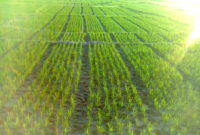Rice is a staple food for over three billion people worldwide. By 2050, it is predicted that there could be another billion rice eaters in Asia. For this reason, scientists are working to breed new varieties, which promise higher yields. The traditional remedy in this area – greater output from higher inputs – was fundamentally questioned by a new method of cultivation developed in the early 1980s by French Jesuit priest and agronomist Henri de Laulanié. After many years of observation in field trials with small-scale farmers in Madagascar, he came up with the System of Rice Intensification (SRI); a system that requires less input but achieves greater output.

Techniques followed in the system of SRI
Nursery preparation:
- A place with suitable irrigation and drainage facilities is needed to get good seedlings within 12 days.
- A nursery area of 100 sq. m. is prepared. This is all that is required for planting one hectare of crop (just 2.5 cents).
- A 300 gauge polythene sheet, 200ft in length and 1m in breadth, is required for raising enough seedlings for one hectare.
- A frame with dimensions of 1m length, 0.5m breath and 4cm height, is required for sowing the seeds.
- The frame is filled with press-mud or other compost.
- 5kg of sprouted seeds, treated with azospirillum and phosphobacterium, are required for sowing one hectare. These are planted at the rate of 45g per compartment, and the seeds are covered lightly with sieved press mud.
- Watering is done with a sprinkling can twice daily until the fifth day.
- A 0.5% urea spray is applied on the 8th day, dissolving 150g in 30 liters of water.
- Twelve-day-old seedlings, with their roots and seed sacs still kept in the cake, are taken to the main field for transplantation
Transplantation
First transplantation
- A small area of 8 cents in one corner of the field is prepared for transplanting the 12 day old young seedlings. It is enough for later transplanting one hectare.
- In this small portion, 4 to 5 seedling are planted per hill at a square spacing of 15cm between hills.
- On the 15th day, 0.5% urea spray is given.
- By 28 days, the paddy seedlings will be well-grown, 25cm height, with good root growth.
Second transplantation :
- At 30 days, the seedlings are carefully removed from these first hills and are separated and spread over the entire main field, with a spacing of 20x20cm between single plants.
- This work can be done for a hectare by 15 laborers in one day.
Advantages of double transplantation
- Seedlings are well grown, and there is zero mortality.
- As the seedlings are well grown, there is little or no weed problem.
- As the seedlings are tall, they are able to tolerate standing water from day one, which permits weed control by flooding.
- Separation of single seedlings is much easier.
- Establishment of the crop is much faster, and it is possible to work with the cono-weeder from the 10th day.
- No special training or effort is needed for this technology as all preparations can done be the same way that farmers usually practice rice cultivation.
Weed management
On the 10th day after this second transplanting, a cono-weeder is drawn along and across the rows of plants, being pushed 3 to 4 times in both directions. There is a saving of 10 labor-days/ha as this single weeding is sufficient.
Irrigation
Carry out irrigation so that water is applied only once the soil becomes dry, to keep it moist but never saturated. This reduces irrigation water requirements by about 500mm.
Fertiliser application
- First, phosphorous and potash fertilizer is applied as a basal dose.
- On the 15th day after cono weeding, 30kg of urea is applied.
- Again on the 30th day, 30kg/ha is applied.
- On the 45th day, 30kg/ha along with 30kg potash is applied.
